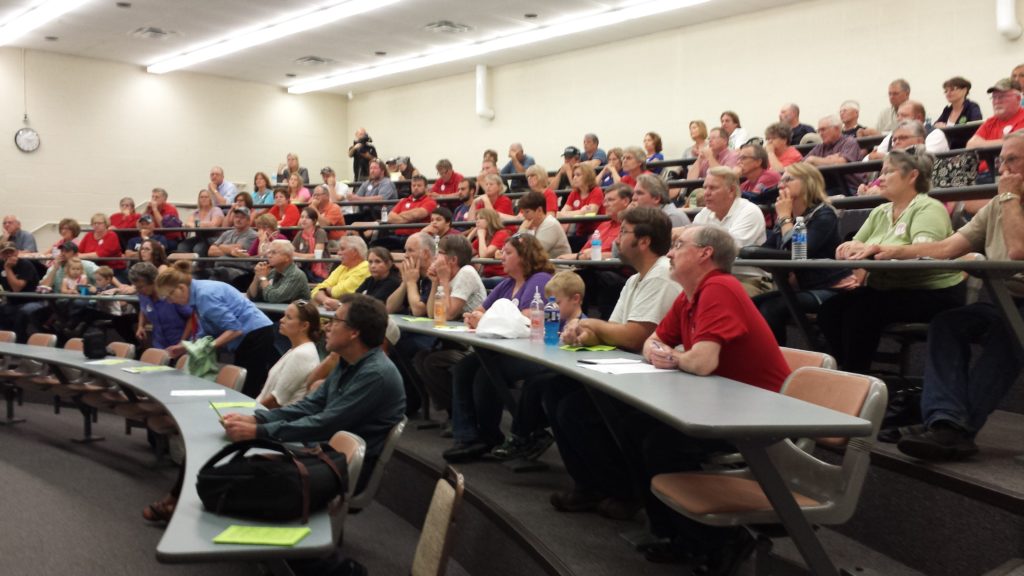AFCL’s MERA suit dismissed
November 29th, 2020

The judge’s Order arrived, and it’s disappointing, to put it mildly.
The judge’s decision focused on the belief that these matters had been litigated in another forum, so we couldn’t do it again. Litigated? Intervention is not necessarily litigation, though certainly AFCL intervened in the Freeborn Wind docket, and certainly did not in the Plum Creek, Three Waters or Buffalo Ridge dockets. And in this District Court proceeding, Lisa Agrimonti let me know that another attorney would be lead in this case, that their firm was putting a “litigator” on it. Hmmmm, Agrimonti’s not a litigator, and put Alethea Huyser on the job, so the firm admits that what we, Freeborn Wind and AFCL, were doing in those dockets was not litigation, right, I get it… uh-huh… sigh…
How do we deal with these systemic problems in wind siting? 25 years and still no rules? Setbacks aren’t sufficient to prevent noise standard violations and people need to leave their homes to be able to sleep, so far two families reached settlements and buyouts to get away from noisy turbines. Wind projects pay out for blinds so people can sit in the dark, or suggest going to Florida, to avoid shadow flicker inflicted on them. At the PPSA Annual Hearing last week, the DOT said it wants the 250 foot setback from roads reevaluated. The Public Utilities Commission has actual and constructive notice of these problems for years, yet nothing happens…
Let’s see… rulemaking Petitions denied over and over. The only time we’ve had a contested case, the judge recommended denial because developer had not demonstrated compliance with noise standard, and recommended a lower number of hours as “acceptable” for shadow flicker.
Once more with feeling — the ONLY time, the FIRST time, in Minnesota history where there was a contested case on a wind siting permit, the only time it could arguably be said the issues were “litigated,” the ALJ recommended that the permit be denied!
WE WON!!! ALJ Recommend Freeborn Permit be DENIED, or…
May 14th, 2018
The PUC turned that around in a private settlement with the developer, excluding intervenors.
Freeborn? PUC upends ALJ’s Freeborn Wind Recommendation
September 21st, 2018
Now what… How many more complaints, how many more landowner settlements, before they fix this mess?
What’s the point of intervening, becoming a party? What’s the point of raising issues at the Power Plant Siting Act Annual Hearing (for 23 years)? What’s the point of over and over raising the systemic problems in the PUC’s wind siting? How do we work “within the system” when the system is broken?

PPSA Annual Hearing NOW
November 20th, 2020

RIGHT NOW! It’s the PPSA Annual Hearing… sigh… here we go again.

Go to webex, Event # 146 311 2620. The powerpoint slides will be here (and will also be filed on eDockets).
To be able to comment, you have to get on the phone 866-609-6127, Conference ID: 4449079, and to comment, you need to press #1 and get in queue.
Here is the Commerce info about this year’s projects:
And for the record, folks, note that wind is not exempt from many of the parts of the PPSA:

Nov. 14th – PPSA Annual Hearing!
October 22nd, 2018

It’s that time of year again, and for a change, no reminder necessary, AND it’s in 2018, not crammed in at the very end of year or beginning of next!
It’s the POWER PLANT SITING ACT ANNUAL HEARING!

This is our opportunity, as those wrestling with the state’s siting laws and rules, and absence thereof, to tell them what does and doesn’t work. Then the Administrative Law Judge files the report and it’s ignored for another year.
Frustration with lack of response was what triggered the multiple rulemaking petitions I’ve filed, on my own as individual, and representing Goodhue Wind Truth, most recently:
Wind Rulemaking — Petition for Reconsideration
We used to have a pot-luck for the PPSA Annual Hearing, until the PUC put the kibosh on that. GRRRRRR! Treats is the best way to get people to show up.
Now’s the time, show up, spout off, and tell them what works and what does not. And note that aspects of the Power Plant Siting Act DO apply to wind:
216F.02 EXEMPTIONS.
(a) The requirements of chapter 216E do not apply to the siting of LWECS, except for sections 216E.01; 216E.03, subdivision 7; 216E.08; 216E.11; 216E.12; 216E.14; 216E.15; 216E.17; and 216E.18, subdivision 3, which do apply.
Respectful wind siting NOW!
May 24th, 2018

The Red Wing Republican bEagle ran my commentary on wind siting, all of it! Short version? Respectful wind siting now! The community must consent!
Viewpoint: Respectful siting process for wind turbines long overdue
By Carol A. Overland, Red Wing
It’s taken a decade, but the Minnesota policy battleship is turning regarding siting of wind projects. State agencies, in their rush to site wind, have dropped the ball — they have failed in their charge to regulate and protect the public and the public interest. We need a respectful siting process, and that is 20 years overdue. If Minnesota doesn’t correct our wind siting process, the legitimate pushback will make siting a wind project difficult at best.
Recently an administrative law judge issued a recommendation that the Freeborn Wind Project be denied because it had not demonstrated it could meet the state’s noise regulation, or in the alternative, give the developers some time to demonstrate how it will comply with noise standards at all times throughout the project footprint.
The Public Utilities Commission will make a permitting decision, typically a month or more out. It’s not final, but this recommendation is a crucial step.
The Freeborn Wind case involves many “firsts.” It is the first project in Minnesota to be sited using the siting criteria of the Power Plant Siting Act (criteria in Minn. Rules 7850). It is the first project in Minnesota where the siting permit was subject to a contested case proceeding, in essence a trial, where the applicant had to prove up its application before an administrative law judge. It is the first project where an administrative law judge has recommended the permit be denied.
Lax rules
Minnesota wind siting has been lax and much of that falls directly on the Department of Commerce. The Environmental Quality Board no longer has siting authority. It’s been that way since 2005, when the Energy Omnibus bill shifted it to Commerce, doing siting “analysis” for PUC — in addition not to using Power Plant Siting Act criteria, and until now, no contested case.
There is no environmental review, no environmental assessment worksheet, no environmental impact statement, required for wind projects. Wind projects, until now, were separated out from the Power Plant Siting Act and permits issued citing the wind statutes and rules Minnesota Statute 216F and Minnesota Rules 7854, which have NO siting criteria at all? All wind siting permits cite only Statue 216F and Rule 7854 as permitting authority! That compartmentalization is the doing of the Department of Commerce.
There are small wind “standards,” which were ordered in 2008, but that was not a rulemaking. It was a process that was a too fast response to a legislative mandate, and in essence, the PUC took small wind standards and stamped them as “Large Wind Energy Conversion System” standards.
Nothing has been done since, despite pre- and post-construction complaints, suggestions, interventions and rulemaking petitions. State agencies, in their rush to site wind, have failed in their charge to regulate and protect the public and the public interest.
Issues are real
Wind projects are by definition the nuisance moving to the landowners. All are sited where there’s an established community, and the wind projects lease land in patchwork sites for their projects. Communities are steamrolled. The way projects are sited, it’s inevitable that homes are surrounded, and turbines are close to homes.
Noise issues are real. Noise modeling isn’t necessarily predictive, and siting often doesn’t allow for margin of error. Shadow flicker is real, but landowners are provided with blinds to live in the dark or are told to take a trip to Florida during times of heavy shadow flicker. Eagle nests are not accounted for, or in one case, blown away by helicopter, and in another, removed after getting a permit.
It’s time to develop thoughtful and respectful siting; It’s long overdue. We can establish standards and rules so that wind projects are projects people can live with. We can require modeling that provides for margin of error. We can take into account the feelings of non-participants who already live in the area and will be affected by a project moving in. The community must consent.
Looking forward, if Minnesota doesn’t alter siting regulations and practices, it’s going to be very difficult to site wind projects.
There’s also a problem looking backward, for there are people now living in the midst of improperly sited wind projects. Not only does Minnesota need to address siting issues, but Minnesota needs to develop policies for those living near and affected by wind projects, as has been done for other types of utility projects. There are at least two wind project permits now before the Public Utilities Commission regarding noise and
Minnesota’s noise regulation. Wind turbines are massive structures with 55-foot diameter concrete foundations — it’s not like we can just pick them up and move them.
Permits say that if there are violations, the violations must be corrected, or the permit can be suspended and/or revoked. In short, solutions to problems in existing wind developments are not easy, and few options are practical.
What to do? A start is to revamp Minnesota’s permit complaint process, which is occurring now in one docket. The revised complaint process, after public comment and a hearing, should be applied to all permits.
Another step is to enact an “opt out,” similar to the “Buy the Farm” option for transmission (Minnesota Statute 216E.12, Subd. 4, where affected landowners can make the utility buy them out rather than live under a transmission line.
Other ideas include a promulgation and revamp of PUC and MPCA rules, which is a multi-year process.
Policy takes a long time to change. Will Minnesota’s agencies, utilities, wind developers, landowners, and legislators work on the changes or will it be a continued fight? Do utilities want to site wind projects in Minnesota?
With the developments over the last year, I’m encouraged that Minnesota will work toward respectful siting. Let’s make it happen.
Carol A. Overland is a Red wing attorney who represents Association of Freeborn County Landowners.
p.s. Minnesota’s existing Wind Standards and Exhibit A.
Comment Filed – Power Plant Siting Act
February 9th, 2018

Yes, it’s that time of year again, and today’s the deadline for Comments for the Power Plant Siting Act Annual Hearing:
And there ya have it. Until next year…